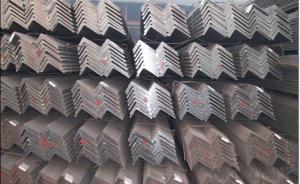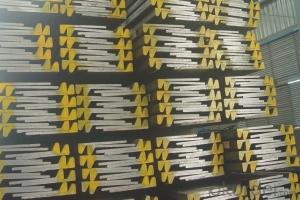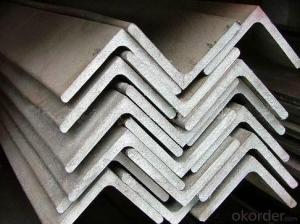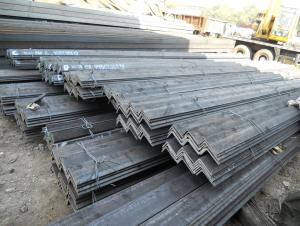Unequal Angle Steel HR Q235-420Series, SS400-540Series, S235JR-S355JR, A36-A992
- Loading Port:
- Tianjin
- Payment Terms:
- TT or LC
- Min Order Qty:
- 30 m.t.
- Supply Capability:
- 38000 m.t./month
OKorder Service Pledge
OKorder Financial Service
You Might Also Like
Product Description:
OKorder is offeringUnequal Angle Steel HR Q235-420Series, SS400-540Series, S235JR-S355JR, A36-A992at great prices with worldwide shipping. Our supplier is a world-class manufacturer of steel, with our products utilized the world over. OKorder annually supplies products to European, North American and Asian markets. We provide quotations within 24 hours of receiving an inquiry and guarantee competitive prices.
Product Applications:
Unequal Angle Steel HR Q235-420Series, SS400-540Series, S235JR-S355JR, A36-A992 are ideal for structural applications and are widely used in the construction of buildings and bridges, and the manufacturing, petrochemical, and transportation industries.
Product Advantages:
OKorder'sUnequal Angle Steel HR Q235-420Series, SS400-540Series, S235JR-S355JR, A36-A992are durable, strong, and resist corrosion.
Main Product Features:
· Premium quality
· Prompt delivery & seaworthy packing (30 days after receiving deposit)
· Corrosion resistance
· Can be recycled and reused
· Mill test certification
· Professional Service
· Competitive pricing
Packaging & Delivery:
Packaging Detail: products are packed in bundle and then shipped by container or bulk vessel, deformed bar is usually naked strapping delivery, when storing, please pay attention to moisture proof. The performance of rust will produce adverse effect.
Each bundle weight: 2-3MT, or as required
Payment term: TT or L/C
Delivery Detail: within 45 days after received advanced payment or LC.
Label: to be specified by customer, generally, each bundle has 1-2 labels
Trade terms: FOB, CFR, CIF
FAQ:
Q1: Why buy Materials & Equipment from OKorder.com?
A1: All products offered byOKorder.com are carefully selected from China's most reliable manufacturing enterprises. Through its ISO certifications, OKorder.com adheres to the highest standards and a commitment to supply chain safety and customer satisfaction.
Q2: How do we guarantee the quality of our products?
A2: We have established an advanced quality management system which conducts strict quality tests at every step, from raw materials to the final product. At the same time, we provide extensive follow-up service assurances as required.
Q3: How soon can we receive the product after purchase?
A3: Within three days of placing an order, we will begin production. The specific shipping date is dependent upon international and government factors, but is typically 7 to 10 workdays.
Images:
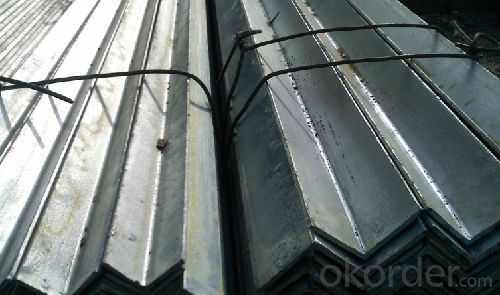
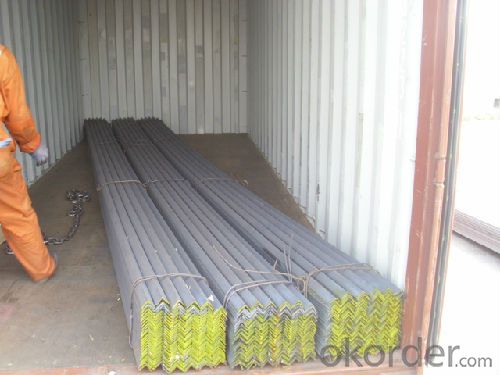
- Q:Are steel angles available in different finishes?
- Indeed, there are a variety of finishes available for steel angles. To enhance their appearance or provide extra protection against corrosion, steel angles can undergo different coatings or treatments. Some popular finishes for steel angles include galvanized, painted, or powder-coated options. Galvanized steel angles are coated with a layer of zinc to prevent rusting, while painted or powder-coated finishes offer a wide range of color choices for aesthetic purposes. Moreover, steel angles can also be left unfinished, creating a raw and industrial look. The diverse range of finishes for steel angles provides greater flexibility in their applications, allowing them to be customized to meet specific functional and aesthetic requirements.
- Q:How do steel angles contribute to the overall torsional stiffness of a structure?
- Steel angles contribute to the overall torsional stiffness of a structure by providing resistance against torsional forces. The angled shape of the steel members helps to distribute and transfer these forces, preventing excessive twisting or rotation of the structure. This added stiffness helps to maintain structural integrity and stability, ensuring that the structure can withstand torsional loads and maintain its desired shape.
- Q:Can steel angles be used for manufacturing equipment frames?
- Yes, steel angles can be used for manufacturing equipment frames. Steel angles are commonly used in construction and industrial applications due to their strength, durability, and versatility. They provide structural support and stability, making them suitable for creating frames for various types of equipment.
- Q:What are the typical lead times for steel angle orders?
- The typical lead times for steel angle orders can vary depending on several factors. Generally, lead times for standard steel angles that are readily available in stock can range from a few days to a week. This is because these standard sizes are commonly produced and kept in inventory by steel suppliers. However, if the steel angle order requires specific dimensions, finishes, or special requirements, the lead times can be longer. Custom or non-standard steel angles may need to be fabricated or sourced from mills, which can add additional time to the order fulfillment process. Lead times for such orders can range from a few weeks to several months, depending on the complexity of the specifications and the availability of the required materials. It is important to note that lead times can also be influenced by external factors such as market demand, production schedules, and transportation logistics. Therefore, it is recommended to communicate with the steel supplier or manufacturer to get an accurate estimation of the lead times for specific steel angle orders.
- Q:How do steel angles resist bending or deflection?
- Steel angles resist bending or deflection due to their shape and material properties. The L-shape of steel angles provides structural rigidity, preventing excessive bending or deflection under load. Additionally, the high tensile strength and stiffness of steel as a material enable angles to withstand external forces and distribute them evenly, ensuring minimal bending or deflection.
- Q:How do you determine the plastic section modulus of a steel angle?
- In order to determine the plastic section modulus of a steel angle, a specific calculation process must be followed. The plastic section modulus (Z) is used to assess the ability of a cross-section to resist plastic bending and is commonly employed in structural engineering to analyze the strength and stability of members. To calculate the plastic section modulus of a steel angle, it is necessary to know the dimensions of the angle cross-section, including the length of the legs and the thickness of the steel. Once these measurements are obtained, the following steps can be carried out: 1. The centroid of the angle cross-section must be identified. This centroid serves as the geometric center of the shape and is a crucial reference point for calculating the plastic section modulus. By determining the average of the coordinates of the vertices, the centroid can be found. 2. The moment of inertia (I) needs to be calculated. The moment of inertia provides a measure of how the area is distributed around the centroid. It can be determined by summing the individual moments of inertia for each component of the cross-section. For a steel angle, the moment of inertia can be calculated using standard formulas or tables. 3. The plastic section modulus (Z) must be determined. The plastic section modulus is directly related to the moment of inertia. It can be computed by dividing the moment of inertia (I) by the distance from the centroid to the outermost fiber of the section. This distance, known as the distance to the extreme fiber (c), is typically equal to half the thickness of the angle. The formula to calculate the plastic section modulus (Z) is Z = I / c. 4. The values obtained for the moment of inertia (I) and the distance to the extreme fiber (c) should be substituted into the formula to calculate the plastic section modulus (Z). By following these steps, the plastic section modulus of a steel angle can be determined. This parameter is crucial for assessing the structural behavior and design of steel angles, particularly when subjected to bending loads.
- Q:Can steel angles be used for transportation infrastructure projects?
- Yes, steel angles can be used for transportation infrastructure projects. Steel angles are commonly used in the construction industry for various applications, including transportation infrastructure projects such as bridges, highways, and railways. They provide structural support and stability to these structures, making them strong and durable. Steel angles are versatile and can be easily fabricated and installed, making them an ideal choice for transportation infrastructure projects where strength and reliability are crucial. Additionally, steel angles have high load-bearing capacity and resistance to environmental factors, ensuring the longevity and safety of the transportation infrastructure. Consequently, steel angles are widely utilized in transportation infrastructure projects worldwide.
- Q:Can steel angles be used in cold climates?
- Yes, steel angles can be used in cold climates. Steel is known for its durability and strength, making it suitable for various weather conditions, including cold climates. However, it is important to consider the specific requirements and properties of the steel angles being used to ensure they are appropriate for the specific cold climate conditions, such as low temperatures, snow, and ice. Proper insulation and protective coatings may also be necessary to enhance their performance and longevity in cold climates.
- Q:What are the different types of steel angles used in automotive manufacturing?
- In automotive manufacturing, there are several types of steel angles that are commonly used. These steel angles are crucial components in the construction and design of various automotive structures and parts. Some of the different types of steel angles used in automotive manufacturing include: 1. Equal Angle: This type of steel angle has equal length sides that form a 90-degree angle. Equal angles are typically used in automotive manufacturing for structural applications, such as chassis frames, brackets, and suspension components. 2. Unequal Angle: As the name suggests, unequal angles have unequal length sides that form a 90-degree angle. These angles are commonly used in automotive manufacturing to create components with specific dimensions and angles, such as door frames, body reinforcements, and support structures. 3. L Angle: L angles, also known as angle irons, have two equal length sides that form a 90-degree angle. They are widely used in automotive manufacturing for various purposes, including reinforcing panels, mounting brackets, and structural supports. 4. T Angle: T angles have one long side and one short side that form a 90-degree angle, resembling the letter "T." They are commonly utilized in automotive manufacturing for joining different components, such as body panels, fenders, and roof structures. 5. C Angle: C angles, also called channel angles, have a C-shaped cross-section. They are extensively used in automotive manufacturing for applications requiring structural strength and rigidity, such as frame rails, roll cages, and support beams. 6. Z Angle: Z angles have a Z-shaped cross-section, resembling the letter "Z." They are commonly employed in automotive manufacturing for joining and reinforcing various components, such as door frames, roof structures, and body reinforcements. These are just a few examples of the different types of steel angles used in automotive manufacturing. Each type serves a specific purpose and offers unique properties, such as strength, stability, and flexibility, to meet the requirements of different automotive applications.
- Q:What is the maximum deflection allowed for a steel angle beam?
- The maximum deflection allowed for a steel angle beam typically depends on the specific design requirements, loading conditions, and industry standards. To determine the maximum deflection, engineers consider factors such as the beam's span, material properties, and the desired level of rigidity. Therefore, there is no standard maximum deflection for all steel angle beams, as it varies based on the specific application and design considerations.
1. Manufacturer Overview |
|
|---|---|
| Location | |
| Year Established | |
| Annual Output Value | |
| Main Markets | |
| Company Certifications | |
2. Manufacturer Certificates |
|
|---|---|
| a) Certification Name | |
| Range | |
| Reference | |
| Validity Period | |
3. Manufacturer Capability |
|
|---|---|
| a)Trade Capacity | |
| Nearest Port | |
| Export Percentage | |
| No.of Employees in Trade Department | |
| Language Spoken: | |
| b)Factory Information | |
| Factory Size: | |
| No. of Production Lines | |
| Contract Manufacturing | |
| Product Price Range | |
Send your message to us
Unequal Angle Steel HR Q235-420Series, SS400-540Series, S235JR-S355JR, A36-A992
- Loading Port:
- Tianjin
- Payment Terms:
- TT or LC
- Min Order Qty:
- 30 m.t.
- Supply Capability:
- 38000 m.t./month
OKorder Service Pledge
OKorder Financial Service
Similar products
New products
Hot products
Hot Searches
Related keywords
